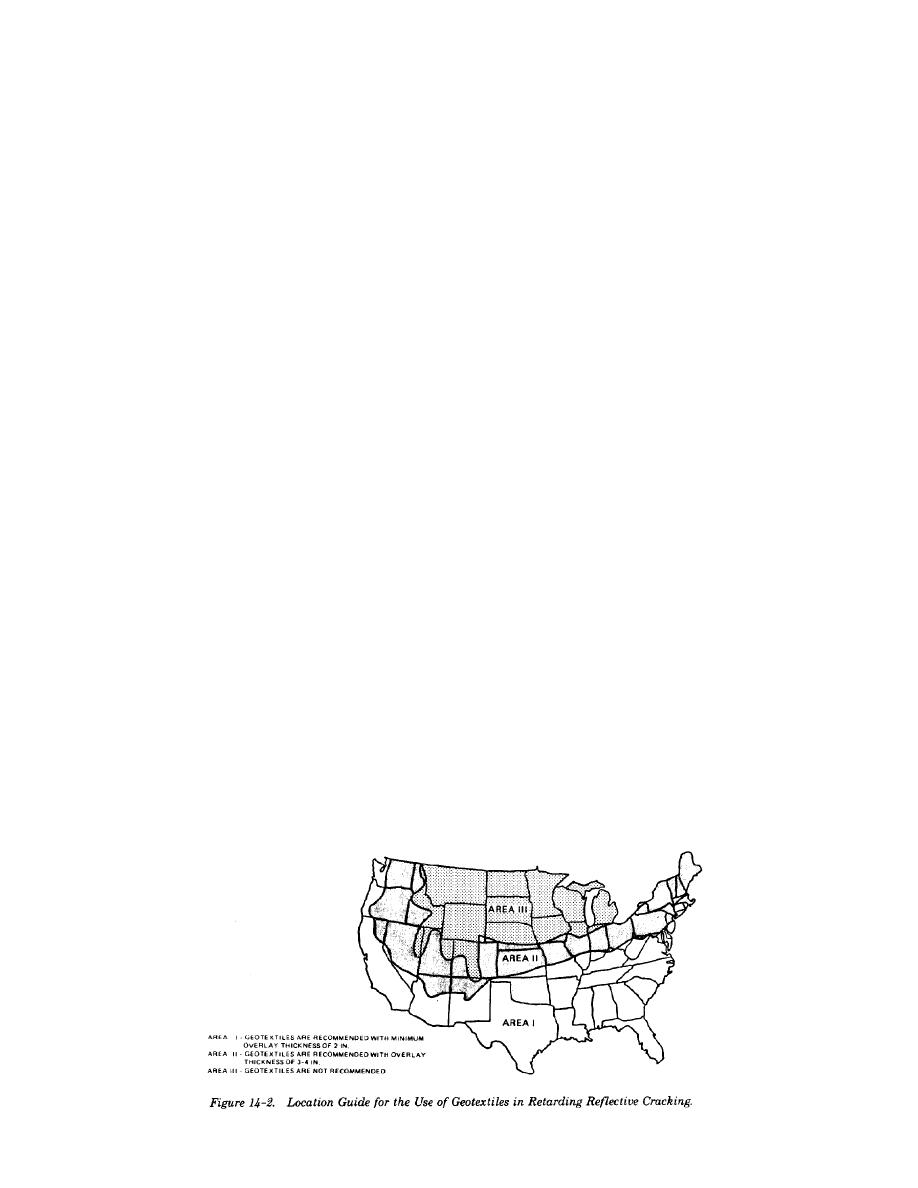
TM 5-822-5/AFM 88-7, Chap. 1
c. Jointing Normally, joints, other than those
tive cracking in some areas of the United States, as
required for construction of a bituminous concrete
shown in figure 14-2. When geotextiles are used
pavement, will not be required in flexible overlays
under an AC pavement, the existing pavement
of existing rigid pavements. It is good practice to
should be relatively smooth with all cracks larger
attempt to lay out paving lanes in the bituminous
than inch sealed. A leveling course is also rec-
concrete to prevent joints in the overlay from coin-
ommended before application of the fabric to ensure
ciding with joints in the rigid base pavement.
a suitable surface. A tack coat is also required prior
Movements of the existing rigid pavement, both
to placement of the geotextile. The minimum
from contraction and expansion and deflections due
overlay thickness is as shown in figure 14-2. When
to applied loads, cause high concentrated stresses in
using geotextiles under a flexible pavement overlay,
the flexible overlay directly over joints and cracks in
the geotextiles can be used as a membrane strip or
the existing rigid pavements. These stresses may
a full-width application. The existing pavement
result in cracking, often referred to as reflection
should be stable with negligible movement under
cracks, in the overlay. The severity of this type
loads and all joints and cracks larger than inch
cracking will, in part, depend upon the type of rigid
sealed. With the strip method, the geotextile is
pavement. For example, a plain concrete pavement
applied directly on the concrete joints and cracks
normally will have closely spaced joints and may
and then overlaid. With the full-width method, the
result in reflection cracks over the joints, but the
geotextile can be applied directly to the existing
cracks will be fairly tight and less likely to ravel.
pavement or placed on a leveling course. It has also
Nevertheless, reinforced concrete pavements will
been observed that in flexible overlays, the lower
normally have joints spaced farther apart, which
viscosity (or higher penetration grade) asphalts are
will, in turn, experience larger movements. The
less likely to experience reflective cracking.
reflection cracks over these joints are more likely to
Therefore, the lowest viscosity grade asphalt that
ravel and spall. Likewise, either existing plain
will provide sufficient stability during high
concrete or reinforced concrete pavements may
temperatures should be used.
have expansion joints that experience rather large
movements, and consideration may be given to
14-10. Overlays in Frost Regions.
provide an expansion joint in the flexible overlay to
Whenever the subgrade is susceptible to differen-
coincide with the expansion joint in the existing
tial heaving or weakening during the frost-melt
pavement. No practical method has been developed
period, the overlay design should meet the require-
to absolutely prevent reflective cracking in flexible
ments for frost action as given in chapter 17.
overlays; however, experience has shown that the
When it is determined that distress in an existing
degree of cracking is related to the thickness of the
pavement has been caused by differential heaving
overlay, with the thinner overlays exhibiting the
due to frost action, an overlay may not correct the
greater tendency to crack.
condition unless the combined thickness of the
pavement is sufficient to prevent substantial frost
14-9. Use of Geotextiles to Retard Reflective
penetration into the underlying frost-susceptible material.
Cracking.
Geotextiles have been effective in retarding reflec-
14-6



 Previous Page
Previous Page
